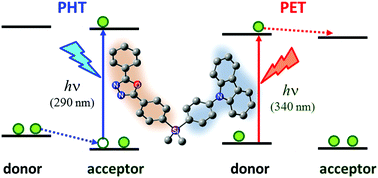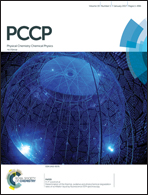Influence of π-conjugation structural changes on intramolecular charge transfer and photoinduced electron transfer in donor–π–acceptor dyads†
Abstract
The influence of π-conjugation structural changes on photoinduced electron transfer (PET) and intramolecular charge transfer (ICT) processes in π-conjugated donor (D)–acceptor (A) dyads (D–π–A) was investigated. Three types of D–π–A dyads were prepared through the modification of the structure of their π-conjugated linker, including D–π–A (1) and D–πtw–A (2) having a twisted π-conjugation, and D–π–Si–π–A (3) with a π-conjugation severed by a Si-atom. In these dyads, carbazole (Cz) and oxadiazole (Oz) moieties act as an electron donor and acceptor, respectively. The emission maxima of dyads 1 and 3 red-shifted with the increase in polarity, which could be attributed to the ICT process. The fluorescence lifetimes of dyads 1 and 3 were 2.64 and 4.29 ns in CH2Cl2, respectively. In contrast, dyad 2 showed dual emission at 350 and 470 nm in CH2Cl2. The emission of dyad 2 at 380 nm corresponded to the monomer fluorescence in the locally excited state. Moreover, the emission at 470 nm increased simultaneously with the diminishing of the fluorescence at 380 nm. This emission band can be assigned as the intramolecular exciplex emission, and showed a strong solvatochromic shift. The low emission quantum yield (<3%) of dyad 2 is due to the PET process. In dyad 2, the cationic and anionic radical species generated by the PET process were confirmed by femtosecond transient absorption (fs-TA) spectroscopy. Upon photoexcitation at 290 or 340 nm, the A or D moieties can be selectively excited. Upon excitation at 290 nm, the acceptor moiety can be excited to the 1A* state, thus the photoinduced hole transfer (PHT) takes place from 1A* to D through the HOMO levels within a few picoseconds. On the other hand, when the donor moiety is excited at 340 nm, the PET process occurs from 1D* to A. Based on the fs-TA studies, it was found that the dynamics and mechanisms for the electron (or charge) transfer were strongly affected by the variation of the π-conjugation of the linker. Herein, we can conclude that the PET and ICT processes are strongly influenced by the π-conjugation properties and their mechanisms are also affected by whether selective excitation of the donor or acceptor moiety occurs. Moreover, unit electron transfers (PET or PHT) were observed dominantly in the dyads having severed/twisted linkers in π-conjugation. However, dyad 1 possessing a well-conjugated linker showed a partial charge transfer character.


 Please wait while we load your content...
Please wait while we load your content...